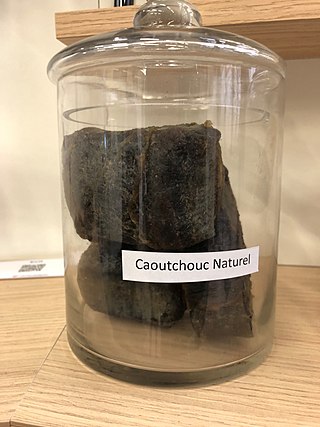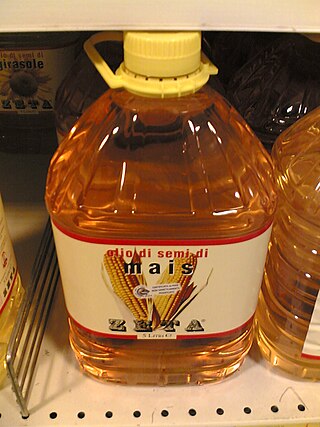Related Research Articles

Paint is a liquid pigment that, after applied to a solid material and allowed to dry, adds a film-like layer, in most cases to create an image, known as a painting. Paint can be made in many colors and types. Most paints are either oil-based or water-based, and each has distinct characteristics.

Rubber, also called India rubber, latex, Amazonian rubber, caucho, or caoutchouc, as initially produced, consists of polymers of the organic compound isoprene, with minor impurities of other organic compounds. Thailand, Malaysia, Indonesia, and Cambodia are four of the leading rubber producers.

Flax, also known as common flax or linseed, is a flowering plant, Linum usitatissimum, in the family Linaceae. It is cultivated as a food and fiber crop in regions of the world with temperate climates. Textiles made from flax are known in English as linen and are traditionally used for bed sheets, underclothes, and table linen. Its oil is known as linseed oil. In addition to referring to the plant, the word "flax" may refer to the unspun fibers of the flax plant. The plant species is known only as a cultivated plant and appears to have been domesticated just once from the wild species Linum bienne, called pale flax. The plants called "flax" in New Zealand are, by contrast, members of the genus Phormium.

A triglyceride is an ester derived from glycerol and three fatty acids. Triglycerides are the main constituents of body fat in humans and other vertebrates, as well as vegetable fat. They are also present in the blood to enable the bidirectional transference of adipose fat and blood glucose from the liver, and are a major component of human skin oils.

Vegetable oils, or vegetable fats, are oils extracted from seeds or from other parts of fruits. Like animal fats, vegetable fats are mixtures of triglycerides. Soybean oil, grape seed oil, and cocoa butter are examples of seed oils, or fats from seeds. Olive oil, palm oil, and rice bran oil are examples of fats from other parts of fruits. In common usage, vegetable oil may refer exclusively to vegetable fats which are liquid at room temperature. Vegetable oils are usually edible.

Ebonite is a brand name for a material generically known as hard rubber, obtained via vulcanizing natural rubber for prolonged periods. Ebonite may contain from 25% to 80% sulfur and linseed oil. Its name comes from its intended use as an artificial substitute for ebony wood. The material has also been called vulcanite, although that name formally refers to the mineral vulcanite.

Linseed oil, also known as flaxseed oil or flax oil, is a colourless to yellowish oil obtained from the dried, ripened seeds of the flax plant. The oil is obtained by pressing, sometimes followed by solvent extraction.

Kenaf [etymology: Persian], Hibiscus cannabinus, is a plant in the family Malvaceae also called Deccan hemp and Java jute. Hibiscus cannabinus is in the genus Hibiscus and is native to Africa, though its exact origin is unknown. The name also applies to the fibre obtained from this plant. Kenaf is one of the allied fibres of jute and shows similar characteristics.

Hevea brasiliensis, the Pará rubber tree, sharinga tree, seringueira, or most commonly, rubber tree or rubber plant, is a flowering plant belonging to the spurge family Euphorbiaceae originally native to the Amazon basin, but is now pantropical in distribution due to introductions. It is the most economically important member of the genus Hevea because the milky latex extracted from the tree is the primary source of natural rubber.

Expeller pressing is a mechanical method for extracting oil from raw materials. The raw materials are squeezed under high pressure in a single step. When used for the extraction of food oils, typical raw materials are nuts, seeds and algae, which are supplied to the press in a continuous feed. As the raw material is pressed, friction causes it to heat. In the case of harder nuts the material can exceed temperatures of 120 °F (49 °C).
Linola is the trademark name of solin, cultivated forms of flax bred for producing linseed oil with a low alpha-linolenic acid content. Linola was developed in the early 1990s by the Commonwealth Scientific and Industrial Research Organisation (CSIRO). It was developed and released in Australia in 1992 and first commercially grown in 1994. Australian Linola varieties are named after Australian lakes.

Corn oil or maize oil (British) is oil extracted from the germ of corn (maize). Its main use is in cooking, where its high smoke point makes refined corn oil a valuable frying oil. It is also a key ingredient in some margarines. Corn oil is generally less expensive than most other types of vegetable oils.

Guizotia abyssinica is an erect, stout, branched annual herb, grown for its edible oil and seed. Its cultivation originated in the Eritrean and Ethiopian highlands, and has spread to other parts of Ethiopia. Common names include noog/nug ; niger, nyger, or nyjer seed ; ramtil or ramtilla; inga seed; and blackseed.
Nitrile rubber, also known as nitrile butadiene rubber, NBR, Buna-N, and acrylonitrile butadiene rubber, is a synthetic rubber derived from acrylonitrile (ACN) and butadiene. Trade names include Perbunan, Nipol, Krynac and Europrene. This rubber is unusual in being resistant to oil, fuel, and other chemicals.

Perilla oil is an edible vegetable oil derived from perilla seeds. Having a distinct nutty aroma and taste, the oil pressed from the toasted perilla seeds is used as a flavor enhancer, condiment, and cooking oil in Korean cuisine. The oil pressed from untoasted perilla seeds is used for non-culinary purposes.

Madhuca longifolia is an Indian tropical tree found largely in the central, southern, north Indian plains and forests, Nepal, Myanmar and Sri Lanka. It is commonly known as madhūka, madkam, mahuwa, Butter Tree, mahua, mahwa, mohulo, Iluppai, Mee or vippa chettu. It is a fast-growing tree that grows to approximately 20 meters in height, possesses evergreen or semi-evergreen foliage, and belongs to the family Sapotaceae. It is adaptable to arid environments, being a prominent tree in tropical mixed deciduous forests in India in the states of Odisha, Chhattisgarh, Jharkhand, Uttar Pradesh, Bihar, Maharashtra, Andhra Pradesh, Madhya Pradesh, Kerala, Gujarat, West Bengal and Tamil Nadu.

Soy paint is paint made primarily from soy, it combines the advantage of being a renewable resource with the potential of non-toxic product.

An oil mill is a grinding mill designed to crush or bruise oil-bearing seeds, such as linseed or peanuts, or other oil-rich vegetable material, such as olives or the fruit of the oil palm, which can then be pressed to extract vegetable oils, which may used as foods or for cooking, as oleochemical feedstocks, as lubricants, or as biofuels. The pomace or press cake – the remaining solid material from which the oil has been extracted – may also be used as a food or fertilizer.
Mucuna bracteata is a leguminous plant. It is a nitrogen-regulating plant that is used in agroecosystems operating around certain types of agricultural plant systems including: rubber trees, oil palm, citrus and coconut. M. bracteate is a cover crop which helps to cover and shield the soil from weeds or plants, as well as providing rapid growth for existing agricultural crops, preventing soil erosion, and providing nitrogen fixation. The Mucuna bracteata crop grows about 10–15 cm/day in conditions similar to those that rubber and palm oil plants thrive in.
References
- ↑ Shankaransh Srivastava,"Effects of Blends of Rubber Seed Oil on Engine performance and Emissions"
- ↑ Bun Tean, eo Sath, Pok Samkol and J Ly, "Utilization by pigs of diets containing Cambodian rubber seed meal"
- ↑ Gv Mallika, ER Jansz and Nirmala M Pieris, 1991, "Cyanogenic Glucosides and Glucosidases of Rubber Seed Kernel" J. Natn Sci Coun. Sri Lanka
- ↑ Uzu, F. O.; Ihenyen, G. A.; Chukwuma, F. and Imoebe, S. O. (1985). Processing, analysis and utilization of rubber seed oil and cake. Paper presented at the National Conference on Industrial utilization of Natural rubber seed, latex and wood. Rubber Research Institute of Nigeria, Benin City, 22nd-24th Jan. 7 pp.
- ↑ Thomas, V.; Mercykutty, V. C. and Saraswathyamma, C. K. (1998). Rubber seed: Its biological and industrial applications. Planter (Malaysia). 74 (869): 437 - 443.
- ↑ Anon, (1919). Para rubber seed as a source of oil and feeding cake. Bulletin of Imperial Institute. 17: 543-571.
- ↑ Aigbodion, A. I. (1994). Effect of storage of seeds on quality of rubber seed oil. India Journal of Natural Rubber. 92: 141-143.
- ↑ Anon, (1950). Drying oil for the paint industry. Board of Trade Journal. 150: 771- 773.
- ↑ Vimal, P.O. (1981). The use of rubber seed. Planter Chronicle (India). 76(7): 333-336.
- ↑ Uzu, F. O.; Ihenyen, G. A.; Chukwuma, F. and Imoebe, S. O. (1985). Processing, analysis and utilization of rubber seed oil and cake. Paper presented at the National Conference on Industrial utilization of Natural rubber seed, latex and wood. Rubber Research Institute of Nigeria, Benin City, 22nd-24th Jan. 7 pp.
- ↑ Thomas, V.; Mercykutty, V. C. and Saraswathyamma, C. K. (1998). Rubber seed: Its biological and industrial applications. Planter (Malaysia). 74 (869): 437 - 443.
- ↑ Green, L. W. and Leaper, J. M. F. (1933). Pure rubber seed oil as a substitute for Linseed oil in founding core binders. Chemical Abstract. 27 pp.
- ↑ http://www.irrdb.com-30/1/2013 [ dead link ]